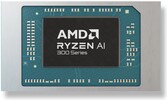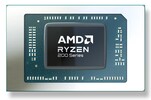AMD Ryzen AI 7 350 vs AMD Ryzen 9 H 270 vs AMD Ryzen 5 240
AMD Ryzen AI 7 350
► remove from comparison
The AMD Ryzen AI 7 350 is a powerful mobile processor from the Krackan Point family that was announced at CES in early 2025. The APU integrates 8 CPU cores (4x Zen 5 with up to 5 GHz and 4x Zen 5c with less cache and a maximum of 3.5 GHz) and a big 16 MB L3-Cache.
Architecture and features
The Krackan Point family APUs are powered by Zen 5 and Zen 5c microarchitecture cores located in separate clusters, the latter being a slightly slower, smaller and more energy efficient version of the former. One of the differences between Zen 5 and Zen 5c is the size of the cache; the Zen 5 cores have larger caches available.
However, the mobile Zen 5 implementation is reportedly (ChipsAndCheese) is closer to desktop Zen 4 than desktop Zen 5 due to the different cache sizes, large differences in AVX-512 throughput, and other factors.
Elsewhere, the Ryzen AI 7 chip supports DDR5-5600 and LPDDR5x-8000 RAM, giving system designers a choice between lower latency and higher throughput. The chip is natively compatible with USB 4 (and therefore Thunderbolt). It has PCIe 4.0 support for a throughput of 1.9 GB/s per lane, just like its 8000 series predecessors. The integrated XDNA 2 NPU, which is much more complex than the first generation XDNA, delivers up to 50 INT8 TOPS for accelerating various AI workloads.
As usual with laptop CPUs, the Ryzen 7 AI chip cannot be replaced by the user as it is soldered.
Performance
Thanks to the Zen 5 architecture and the high clock rates, the CPU performance should be very good.
Graphics
The Radeon 860M is the direct successor to the Radeon 760M and offers 8 cores (CUs = 512 shaders) and clocks at up to 3 GHz. It uses the new RDNA 3.5 architecture.
Power consumption
The AI 350 is said to have a base TDP of 28 W, although laptop manufacturers are free to set the TDP between 15 and 54 W.
The 4 nm TSMC process with which these CPUs are manufactured ensures above-average energy efficiency.
AMD Ryzen 9 H 270
► remove from comparison
The Ryzen 9 H 270 is a rebadged Ryzen 9 270 (or Ryzen 9 8945HS) for China, making it a fast mobile laptop processor. This is an APU of the Hawk Point family that has eight Zen 4 cores running at 4.0 GHz to 5.2 GHz. This APU was introduced at CES 2025 and all of its cores are SMT-enabled for a total of 16 processing threads.
Architecture and Features
Hawk Point family chips are powered by the Zen 4 architecture, much like Phoenix and Dragon Range family chips were. The 16 TOPS NPU present here isn't powerful enough for systems built around the 9 270 to be Copilot+ certified.
Elsewhere, the chip has 16 MB of L3 cache and support for super-fast DDR5-5600 and LPDDR5x-7500 RAM while also being compatible with USB 4 and thus with Thunderbolt. It comes with 20 PCIe 4 lanes, giving fast NVMe SSD up to 7.8 GB/s of throughput.
Please note that this processor is not overclockable and neither is it user-replaceable. It gets soldered to the motherboard for good instead (FP8 socket interface).
Performance
Its CPU performance is slated to be identical to the old Ryzen 9 8945HS and R9 7940HS.
Your mileage may vary depending on how high the CPU power limits are and how competent the cooling solution of your system is.
Graphics
The Radeon 780M has 12 CUs (768 shaders) purring away at up to 2,800 MHz. The Radeon will let you use up to 4 monitors with resolutions as high as SUHD 4320p and it will also HW-decode and HW-encode the most widely used video codecs (such as AV1, HEVC and AVC) without breaking a sweat. As for gaming, most 2024 games run fine at 1080p with settings set to Low on this graphics adapter.
Your mileage may vary depending on how high the CPU power limits are, how competent the cooling solution of the system is, how fast the RAM of the system is (there is no dedicated VRAM here).
Power consumption
This Ryzen 9 series chip has a long-term power limit (default TDP) of 35 W to 54 W, giving laptop makers a choice between longer battery life and higher performance. Either way, an active cooling solution is a must for a system powered by this chip.
The R9 H 270 is built with TSMC's 4 nm process for a reasonably good, as of early 2025, energy efficiency.
AMD Ryzen 5 240
► remove from comparison
The Ryzen 5 240 is an upper mid-range processor (APU) of the Hawk Point family. This isn't an entirely new chip, but a rebadged Ryzen 5 8645HS from 2024. The CPU features 6 SMT-enabled Zen 4 cores (12 threads) running at 4.3 GHz to 5.0 GHz. The Radeon 760M iGPU is responsible for carrying out 3D calculations and similar duties.
Architecture & Features
Hawk Point family chips are powered by the Zen 4 architecture, much like Phoenix and Dragon Range family chips are. That's not to say there is no difference between the three. With Hawk Point, AMD is betting big on generative AI; these chips are promised to deliver an up to 40% increase in generative AI performance over 7040 series APUs making apps like DaVinci Resolve and Adobe Photoshop even more powerful.
Unlike Zen 3, Zen 4 features AVX512 support and, thanks to a plethora of other improvements including larger caches/registers/buffers across the board, is slated to bring a double-digit IPC improvement over the former.
Elsewhere, the R5 240 has 16 MB of L3 cache and a super-fast DDR5-5600 / LPDDR5x-7500 RAM controller. USB 4 (and thus Thunderbolt) is supported natively and so is PCIe 4. In fact, 20 PCIe 4 lanes are on offer; data transfer speeds of up to 7.8 GB/s will be possible provided a sufficiently fast NVMe SSD is used.
Systems powered by this Ryzen 5 series chip are expected to run 64-bit Windows 11, 64-bit Windows 10, or Linux. Please note that the APU is not overclockable and neither will you be able to replace it with a faster one as it gets soldered to the motherboard permanently (FP7, FP7r2, FP8 socket interfaces).
Performance
Since the Ryzen 5 240 is an 8645HX / 7640HS in disguise, it is safe to expect the APU to be about as fast as the Ryzen 9 5900HX, Ryzen 7 6800H, Ryzen 7 7736U and also the Core i5-12500H, as far as multi-thread performance is concerned.
Your mileage may vary depending on how high the CPU power limits are and how competent the cooling solution of your system is.
Graphics
The Radeon 760M has 8 CUs (512 shaders) running at up to 2,600 MHz. While this is not the best graphics adapter for gaming as it's only just fast enough for low quality settings and resolutions such as 1600 x 900, it will let you connect up to four SUHD 4320p monitors and it also HW-encodes and HW-decodes the most widely used video codecs such as AV1, HEVC and AVC without breaking a sweat.
Power consumption
The Ryzen 5 240 has a long-term power limit (default TDP) of 35 W to 54 W, giving laptop makers a choice between improving battery life and giving the system they are working on more oomph. Either way, an active cooling solution is a must for any system powered by the chip.
This Ryzen 5 series APU is built with TSMC's 4 nm process for high, as of late 2023, energy efficiency.
| Model | AMD Ryzen AI 7 350 | AMD Ryzen 9 H 270 | AMD Ryzen 5 240 | ||||||||||||||||||||||||||||||||||||||||||||||||||||||||||||||||||||||||||||||||||||||||||||||||||||||||||||||||
| Codename | Krackan Point (Zen 5) | Hawk Point-HS (Zen 4) | Hawk Point-HS (Zen 4) | ||||||||||||||||||||||||||||||||||||||||||||||||||||||||||||||||||||||||||||||||||||||||||||||||||||||||||||||||
| Clock | 2000 - 5000 MHz | 4000 - 5200 MHz | 4300 - 5000 MHz | ||||||||||||||||||||||||||||||||||||||||||||||||||||||||||||||||||||||||||||||||||||||||||||||||||||||||||||||||
| L2 Cache | 8 MB | 8 MB | 6 MB | ||||||||||||||||||||||||||||||||||||||||||||||||||||||||||||||||||||||||||||||||||||||||||||||||||||||||||||||||
| L3 Cache | 16 MB | 16 MB | 16 MB | ||||||||||||||||||||||||||||||||||||||||||||||||||||||||||||||||||||||||||||||||||||||||||||||||||||||||||||||||
| Cores / Threads | 8 / 16 4 x 5.0 GHz AMD Zen 5 4 x 3.5 GHz AMD Zen 5c | 8 / 16 8 x 5.2 GHz AMD Zen 4 | 6 / 12 6 x 5.0 GHz AMD Zen 4 | ||||||||||||||||||||||||||||||||||||||||||||||||||||||||||||||||||||||||||||||||||||||||||||||||||||||||||||||||
| TDP | 28 Watt | 45 Watt | 45 Watt | ||||||||||||||||||||||||||||||||||||||||||||||||||||||||||||||||||||||||||||||||||||||||||||||||||||||||||||||||
| TDP Turbo PL2 | 54 Watt | ||||||||||||||||||||||||||||||||||||||||||||||||||||||||||||||||||||||||||||||||||||||||||||||||||||||||||||||||||
| Technology | 4 nm | 4 nm | 4 nm | ||||||||||||||||||||||||||||||||||||||||||||||||||||||||||||||||||||||||||||||||||||||||||||||||||||||||||||||||
| Socket | FP8 | FP8 | FP7/FP7r2/FP8 | ||||||||||||||||||||||||||||||||||||||||||||||||||||||||||||||||||||||||||||||||||||||||||||||||||||||||||||||||
| Features | DDR5-5600/LPDDR5x-8000 RAM, PCIe 4, USB 4, XDNA 2 NPU (50 TOPS), Secure Processor, SMT, AES, AVX, AVX2, AVX512, FMA3, MMX (+), SHA, SSE, SSE2, SSE3, SSSE3, SSE4.1, SSE4.2, SSE4A | DDR5-5600/LPDDR5x-7500 RAM, PCIe 4, USB 4, Ryzen AI (16 TOPS), MMX, SSE, SSE2, SSE3, SSSE3, SSE4A, SSE4.1, SSE4.2, AVX, AVX2, AVX-512, BMI2, ABM, FMA, ADX, SMEP, SMAP, SMT, CPB, AES-NI, RDRAND, RDSEED, SHA, SME | DDR5-5600/LPDDR5x-7500 RAM, PCIe 4, Ryzen AI, AES, AVX, AVX2, AVX512, FMA3, MMX (+), SHA, SSE, SSE2, SSE3, SSE4.1, SSE4.2, SSE4A, SSSE3 | ||||||||||||||||||||||||||||||||||||||||||||||||||||||||||||||||||||||||||||||||||||||||||||||||||||||||||||||||
| iGPU | AMD Radeon 860M ( - 3000 MHz) | AMD Radeon 780M ( - 2800 MHz) | AMD Radeon 760M ( - 2600 MHz) | ||||||||||||||||||||||||||||||||||||||||||||||||||||||||||||||||||||||||||||||||||||||||||||||||||||||||||||||||
| Architecture | x86 | x86 | x86 | ||||||||||||||||||||||||||||||||||||||||||||||||||||||||||||||||||||||||||||||||||||||||||||||||||||||||||||||||
| Announced | |||||||||||||||||||||||||||||||||||||||||||||||||||||||||||||||||||||||||||||||||||||||||||||||||||||||||||||||||||
| Manufacturer | www.amd.com | www.amd.com | www.amd.com | ||||||||||||||||||||||||||||||||||||||||||||||||||||||||||||||||||||||||||||||||||||||||||||||||||||||||||||||||
| Series | AMD Hawk Point (Zen 4/4c) | AMD Hawk Point (Zen 4/4c) | |||||||||||||||||||||||||||||||||||||||||||||||||||||||||||||||||||||||||||||||||||||||||||||||||||||||||||||||||
| Series: Hawk Point (Zen 4/4c) Hawk Point-HS (Zen 4) |
|
| |||||||||||||||||||||||||||||||||||||||||||||||||||||||||||||||||||||||||||||||||||||||||||||||||||||||||||||||||
| L1 Cache | 512 KB | 384 KB | |||||||||||||||||||||||||||||||||||||||||||||||||||||||||||||||||||||||||||||||||||||||||||||||||||||||||||||||||
| Die Size | 178 mm2 | 178 mm2 | |||||||||||||||||||||||||||||||||||||||||||||||||||||||||||||||||||||||||||||||||||||||||||||||||||||||||||||||||
| max. Temp. | 100 °C | 100 °C |
Benchmarks
Average Benchmarks AMD Ryzen AI 7 350 → 0% n=0
Average Benchmarks AMD Ryzen 9 H 270 → 0% n=0
* Smaller numbers mean a higher performance
1 This benchmark is not used for the average calculation













